Clues from India and Scandinavia
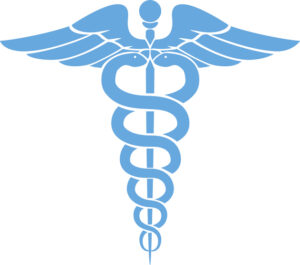
The subject of Dr. Walter Friedlander’s book “The Golden Wand of Medicine” was the caduceus of Hermes as the a symbol of the American medical profession. Today, runaway healthcare costs and inaccessibility of medical care have revived interest in Hermes, the liar, thief and trickster god, and his association with medicine. Who is Hermes, and why is his caduceus chosen as the symbol of American healthcare? This article explores the occult foundations of American Healthcare.
Friedlander focused mainly on Hermes in Greek mythology, but there are echoes of the same deity in other parts of the world. Edward Moor’s “The Hindu Pantheon” provides additional clues about the nature of Hermes. These clues give strength to Dr. Friedlander’s identification of the caduceus of Hermes as a malevolent influence. We begin by identifying deities similar to Hermes in The Hindu Pantheon.
Hermes, Nareda and Thoth
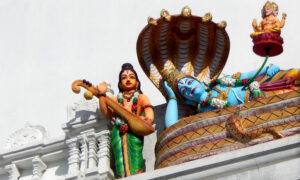
Friedlander stated that it is not known why the Greeks chose to associate Hermes with the Egyptian Thoth, who has a very different personality. Edward Moor’s description of the Hindu deity Nareda provides a possible answer.
Nareda or Narada is a key figure connecting the Hindu scriptures to Hermes, and he has many of the characteristics of Thoth. Nareda is “a wise legislator; great in arms, arts, and eloquence.” He was also an astronomer, a messenger of the gods, and a musician. Also, Nareda invented the Vina, a sort of lute. In these and other points he resembles Hermes, or Mercury.
Moor tells us that Krishna himself claims to be Nareda. Crishna (in the Gita, p. 82) speaks of his ‘holy servants, the Brahmans and the Rajarshis;’ and says, ‘I am Brigu among the Maharshis…and of all the Devarshis I am Narad.’ (P. 80)
The Sivpuran contains the doctrines of the worshipers of Siva. It states that Nareda was born from Brahma’s thigh. But Nareda is also said to be the offspring of both Brahma and Saraswati. In the Hindu Pantheon, Nareda is one of the ten lords of living beings. He was also one of the seven Rishis. The seven Rishis are important characters in the Hindu story of Noah.
Noah

In American Cosmology and Arlington National Cemetery we saw that many of America’s founders were believers in the doctrines of Hermes Trismegistus. However, Hermes was discredited as an historical figure. He was then replaced by Noah.
In the Hindu pantheon, the seventh Menu was Vaivaswata, or child of the sun. Vaivaswata was saved on the ark. Therefore he is the father of the whole human race.
The seven Rishis were said to be with Vaivaswata on the ark. The Rishis are not mentioned as fathers of human families, but Vaivaswata’s “daughter Ila was married…to the first Buddha, or Mercury. He was the son of Chandra, or the Moon. Chandra was a male deity, whose father was Atri, son of Brahma.” Consequently, Vaivaswata’s posterity are divided into two branches. These are the Children of the Sun and the Children of the Moon. The Children of the Sun are from (Vivaswat, the Sun) Vaivaswata’s own father. The Children of the Moon are from the parent of his daughter’s husband.
Buddha and Woden
According to Friedlander, there are five main historical accounts of Hermes. In the classical period, the Homeric version of Hermes changed to become associated with inventing, buying and selling. This was probably due to the influence of Rome and it resulted in the Greek Hermes becoming associated with Mercury.
Moor tells us that Buddha shares the same character with Mercury. So does the Gothic Woden. Each gives his name to the same planet, and to the same day of the week: Budhvar, in India, is the same with Dies Mercurii, or Woden’s day, which is our Wednesday. Buddha, Booda, Butta, and others are varieties of his name in different parts of India. The Bud, or Wud, of the ancient pagan Arabs has the same characteristics. In China his names include Pout in Siam, and Pott, or Poti, in Tibet.
Esculapius, Hermes and Parvati
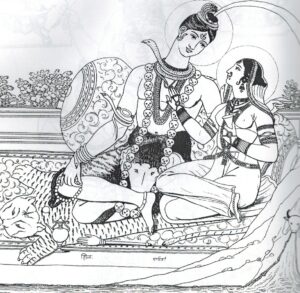
Parvati is the sacti or energy of Siva. She has many additional names. The most common aside from Parvati, are Bhavani, Durga, Kali, and Devi, or the Goddess. Ma is a name of Bhavani in her personification of nature. Under this name, she represents the “general power of fecundity,” and has connections both to Esculapius (Edward Moor’s spelling will be used in this article) and Hermes.
Bhavani is also known as Mahacali, Isani, or Isi. The river Kali, which is the Nile in Egypt, got its name from her, according to Wilford. In the Puranas, she made her first appearance on its banks in the character of Rajarajeswari.
Another name for the Nile is Nahushi, from the warrior and conqueror Deva Nahusha, or Deonaush. Wilford thought Deva Nahusha or Deonaush was probably the Dionysius of the ancient Europeans. Dionysius is often portrayed with similar characteristics to Nareda and Krishna.
Half Woman
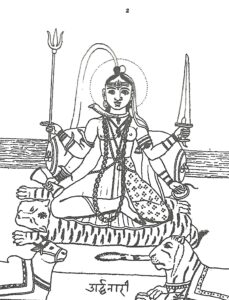
In her character of Bhavani, Parvati was “Venus presiding over generation. This is according to Sir William Jones. In this character, she is sometimes portrayed as having both sexes. She is portrayed this way by her bearded statue at Rome, in the images called Herma-thena, and in her figures which had a conical shape.” (Hermes is also said to be an hermaphrodite)
Time
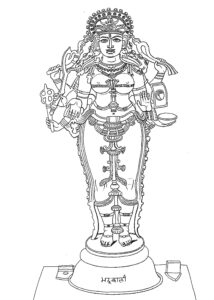
But she has a different character under another name. According to Moor, the word Cala, or Kala, signifies black. Its root, Kal, also means devouring. In this context, Kal is applied to Time, and the feminine is specified in both senses. This is the goddess in her destructive capacity. As Mahacali, she has many other epithets, all implying different shades of black or dark azure, including Cali, or Cala, Nila, Asista, Shyama, or Shyamala, Mekara, Anjanabha, and Krishna.”
As Bhadra-Kali, Maha-Kali, and by other names, she is eight-handed, ashta-buja. In one image of her, one of her right hands holds something like the caduceus of Hermes, without snakes. The caduceus of Hermes was originally topped by a figure-eight with the top open, according to Friedlander.
Bhavani’s Association with Esculapius
Bhavani is also known as Amba, or Uma, and Aranyadevi, or goddess of the forest. She is Prabha, meaning light; and Aswini, a mare, the first of the lunar mansions. “In this shape, the Sun approached her in the form of a horse, and, on their nostrils touching, she instantly conceived the twins; who are called Aswini-Kumari, the two sons of Aswini.” These are beings of importance in the identity of Esculapius.
Sons of Surya
“Surya, (the Sun) “is believed to have descended frequently from his car in a human shape, and to have left a race on earth who are equally renowned in the Indian stories with the Heliades of Greece. His two sons, called Aswina, or Aswini-Cumara together, are considered twin brothers, and painted like Castor and Pollux. They each have the character of Esculapius among the gods, and are believed to have been born of a nymph, who, in the form of a mare, was impregnated with sunbeams.” (Jones. Asiatic researches, Vol. I. p. 263.)
Fourteen Gems and the Beverage of Immortality
Edward Moor calls Dhanwantara the Esculapius of the Hindus. He has an attendant serpent like his brother of Greece. He is a physician and is generally represented as a venerable man, with a book in his hand. Dhanwantara arose from the sea when it was churned for the beverage of immortality.
The Caduceus of Hermes Gets Wings
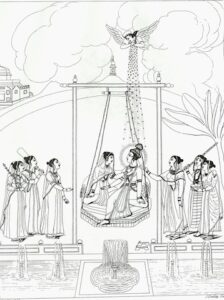
Friedlander says the staff of Esculapius had snakes by the 5th century BC, wings by the 1st century AD, and snakes and wings together by the 15th or 16th century. So, it is interesting that in Moor’s plates, there is an illustration of Krishna with a winged figure. Moor thought this was Krishna’s divine spouse Rukmeny, and he calls this picture ‘singular’. He seems to be saying that the caduceus of Hermes may have developed from the staff of Esculapius.
Esculapius carries a rod with a single snake. Many consider this a more appropriate symbol for a healer.
Pictures from Moor’s “Hindu Pantheon”:
Mahadeva and Parvati: Plate 17
Mahadeva as Ardha Nari: Plate 24, figure 1
Bhadra Kālī and Caduceus: Plate 28
Rādhā, Krishna, and attendant Gopia: Plate 67

i’m rooting for you keep up the good work
Terrific article